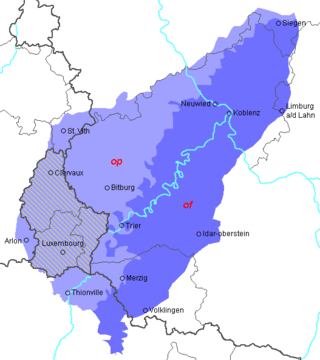Vowels



|
| ||||||||||||||||||||||||||||||||||||||||||||||||||||||||||||||||||||||||||||||||||||
- /i,iː,u,uː,o/ are close to the corresponding cardinal vowels [i, u, o]. [7]
- /e/ is most usually realized as a mid central vowel with slight rounding ([ ə̹ ]). Before velars, it is fronted and unrounded to [ e ], though this is sometimes as open as [ ɛ ]. Contrary to Standard German, the sequence of [ə] and a sonorant never results in a syllabic sonorant; however, Standard German spoken in Luxembourg often also lacks syllabic sonorants, so that e.g. tragen is pronounced [ˈtʀaːɡən], rather than [ˈtʀaːɡŋ̍]. [8] [9]
- /eː,oː/ are higher than close-mid [e̝ː, o̝ː] and may be even as high as /i,u/. [7]
- The quality of /æ/ matches the prototypical IPA value of the ⟨æ⟩ symbol ([ æ ]). [7]
- [ ɐ ] is the realization of a non-prevocalic, unstressed sequence /er/. [7]
- /ɑ/ is near-open [ ɑ̝ ]. [7]
- /aː/, a phonological back vowel (the long counterpart of /ɑ/), is phonetically near-front [ a̠ː ]. Sometimes, it may be as front and as high as /æ/ ([ æː ]), though without losing its length. [10]
- The nasal vowels appear only in loanwords from French, whereas the oral front rounded vowels appear in loans from both French and German. [2]
- The opposition between close-mid and open-mid vowels does not exist in native Luxembourgish words. In non-native words, there is a marginal contrast between the close-mid /øː/ and the open-mid /œː/.
- The short non-native /œ/ is distinct from /e/ only on a phonemic level, as the latter is fronted and unrounded to [ e ] before velars (cf. the surname Böcker /ˈbœker/). In other positions, they are perceived as the same sound, as shown in the spelling of the word ëffentlech[ˈəfəntləɕ] 'public' (loaned from German öffentlich[ˈœfn̩tlɪç], meaning the same). For this reason, it is not differentiated from [ə] in phonetic transcription (so that Böcker is transcribed [ˈbəkɐ]). The long counterpart of this sound is transcribed with ⟨œː⟩ in both types of transcription, which does not imply a difference in quality.
- The starting points of /əɪ,əʊ/ are typically schwa-like [ ə ], but the first element of /əɪ/ may be more of a centralized front vowel [ ë̞ ]. [11]
- The starting points of /æːɪ,æːʊ/, /ɑɪ,ɑʊ/ as well as /iə/ and /uə/ are similar to the corresponding short monophthongs [æ, ɑ, i, u]. [11]
- The first elements of /æːɪ,æːʊ/ may be phonetically short [æ] in fast speech or in unstressed syllables. [11]
- The centering diphthongs end in the mid central unrounded area [ ə ]. [11]
- /oɪ/ appears only in loanwords from Standard German. [2]
The /æːɪ~ɑɪ/ and /æːʊ~ɑʊ/ contrasts arose from a former lexical tone contrast: the shorter /ɑɪ,ɑʊ/ were used in words with Accent 1, whereas the lengthened /æːɪ,æːʊ/ were used in words with Accent 2 (see Pitch-accent language.) [2] The contrast between the two sets of diphthongs is only partially encoded in orthography, so that the fronting /ɑɪ,æːɪ/ are differentiated as ⟨ei⟩ or ⟨ai⟩ vs. ⟨äi⟩, whereas ⟨au⟩ can stand for either /ɑʊ/ or /æːʊ/. The difference is phonemic in both cases and there are minimal pairs such as fein/fɑɪn/ 'elevated' vs. fäin/fæːɪn/ 'decent' and faul/fɑʊl/ 'rotten' vs. faul/fæːʊl/ 'lazy'. The diphthongs contrast mainly in monosyllabics. In penultimate syllables, the short /ɑɪ,ɑʊ/ occur mainly before voiced consonants and in hiatus, whereas the long /æːɪ,æːʊ/ occur mainly before voiceless consonants (including phonetically voiceless consonants that are voiced in their underlying form). The last traces of the dative forms of nouns show a shortening from /æːɪ,æːʊ/ to /ɑɪ,ɑʊ/; compare the nominative forms Läif/læːɪv/ 'body' and Haus/hæːʊz/ 'house' with the corresponding dative forms Leif/lɑɪv/ and Haus/hɑʊz/. [12]
Additional phonetic diphthongs [iːɐ̯,uːɐ̯,oːɐ̯,ɛːɐ̯] arise after vocalisation of /r/ after long vowels. In loanwords from Standard German (such as Lürmann and Röhr ) [yːɐ̯] and [øːɐ̯] also occur. The sequence /aːr/ is monophthongized to [ aː ], unless a vowel follows within the same word. It is also sporadically retained in the environments where it is vocalized after other long vowels, which is why the merger with the monophthong [ aː ] is assumed to be phonetic, rather than phonemic. [13] This variation is not encoded in transcriptions in this article, where the phonetic output of /aːr/ is consistently written with ⟨aː⟩.
/r/ after short vowels is not vocalized but fricativized to [ ʁ ] or [ χ ], depending on the voicing of the following sound (the lenis stops count as voiced despite their being unaspirated with variable voicing). The fricativization and devoicing to [ χ ] also occurs whenever the non-prevocalic /r/ is retained between /aː/ and a fortis consonant, as in schwaarz[ˈʃwaːχts] 'black', alternatively pronounced [ˈʃwaːts]. Thus, before /r/, /aː/ behaves more like a short vowel than a long one. When the following consonant is lenis or the /r/ occurs before a pause, it is unclear whether the more common consonantal realization of /r/ is a fricative or a trill. [4]



